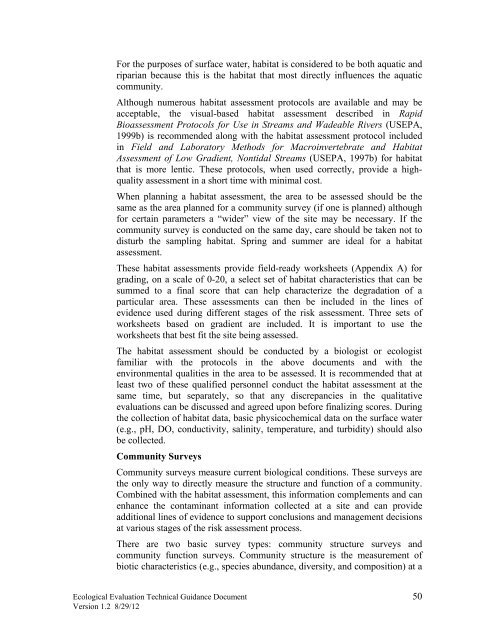Ecological Evaluation Technical Guidance - State of New Jersey
Ecological Evaluation Technical Guidance - State of New Jersey
Ecological Evaluation Technical Guidance - State of New Jersey
- No tags were found...
Create successful ePaper yourself
Turn your PDF publications into a flip-book with our unique Google optimized e-Paper software.
For the purposes <strong>of</strong> surface water, habitat is considered to be both aquatic andriparian because this is the habitat that most directly influences the aquaticcommunity.Although numerous habitat assessment protocols are available and may beacceptable, the visual-based habitat assessment described in RapidBioassessment Protocols for Use in Streams and Wadeable Rivers (USEPA,1999b) is recommended along with the habitat assessment protocol includedin Field and Laboratory Methods for Macroinvertebrate and HabitatAssessment <strong>of</strong> Low Gradient, Nontidal Streams (USEPA, 1997b) for habitatthat is more lentic. These protocols, when used correctly, provide a highqualityassessment in a short time with minimal cost.When planning a habitat assessment, the area to be assessed should be thesame as the area planned for a community survey (if one is planned) althoughfor certain parameters a “wider” view <strong>of</strong> the site may be necessary. If thecommunity survey is conducted on the same day, care should be taken not todisturb the sampling habitat. Spring and summer are ideal for a habitatassessment.These habitat assessments provide field-ready worksheets (Appendix A) forgrading, on a scale <strong>of</strong> 0-20, a select set <strong>of</strong> habitat characteristics that can besummed to a final score that can help characterize the degradation <strong>of</strong> aparticular area. These assessments can then be included in the lines <strong>of</strong>evidence used during different stages <strong>of</strong> the risk assessment. Three sets <strong>of</strong>worksheets based on gradient are included. It is important to use theworksheets that best fit the site being assessed.The habitat assessment should be conducted by a biologist or ecologistfamiliar with the protocols in the above documents and with theenvironmental qualities in the area to be assessed. It is recommended that atleast two <strong>of</strong> these qualified personnel conduct the habitat assessment at thesame time, but separately, so that any discrepancies in the qualitativeevaluations can be discussed and agreed upon before finalizing scores. Duringthe collection <strong>of</strong> habitat data, basic physicochemical data on the surface water(e.g., pH, DO, conductivity, salinity, temperature, and turbidity) should alsobe collected.Community SurveysCommunity surveys measure current biological conditions. These surveys arethe only way to directly measure the structure and function <strong>of</strong> a community.Combined with the habitat assessment, this information complements and canenhance the contaminant information collected at a site and can provideadditional lines <strong>of</strong> evidence to support conclusions and management decisionsat various stages <strong>of</strong> the risk assessment process.There are two basic survey types: community structure surveys andcommunity function surveys. Community structure is the measurement <strong>of</strong>biotic characteristics (e.g., species abundance, diversity, and composition) at a<strong>Ecological</strong> <strong>Evaluation</strong> <strong>Technical</strong> <strong>Guidance</strong> Document 50Version 1.2 8/29/12
















